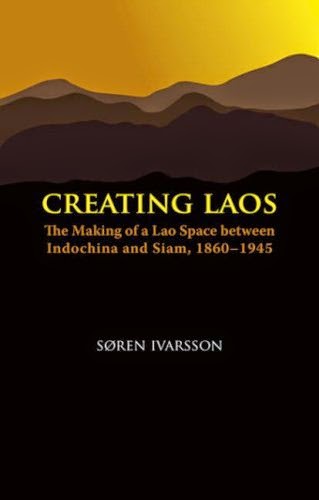By: Soren Ivarsson
Publisher/Year: NIAS Press, 2008
ISBN: 9788776940232
Price: $20
Overall, it is an enthralling and educational read as it combines the topics of Lao identity, history, politics and culture. Whether or not you agree with the author's arguments on how the ideas of Lao identity came to be, you can still appreciate the in-depth analysis he provides and the plethora of details. Note that the book, as the title indicates, specifically covers only periods of 1860 to 1945.
The initial introduction chapter I think is a bit long winded in its discussion of comparing Benedict Anderson and his work called Imagined Communities, as well as, on David Henley's writing. However once you get past that, the author brings it back to how it relates to southeast Asia and specifically Laos.
In the author's own words, the book
...examines the process through which Laos came into existence under French colonial rule, until the end of World War II. Rather than assuming that the Laos we see today was an historical given, this reflection looks at how its position at the intersection of these two conflicting spatial layouts of 'Thailand' and 'Indochina' made its national form a particularly contested process. It is however, not an analysis of nation-building...
Instead, the aim of the book is to discuss how a specific idea about Laos and its culture was formed with reference to divergent discourses on Laos and the Lao.Other interesting factoids mentioned in the book (though not limited to just the below):
- p.27 - We all know the major Lao kingdoms of Luangprabang, Vientiane and Champassak. However, "besides these three kingdoms located in the Mekong valley, the geopolitical map of what was to become Laos was made up by smaller kingdoms like the Phyan Kingdom in Xiengkhuang and a group of smaller chiefdoms like Huaphan and Sipsong Chuthai situated between the Mekong Valley and the Annamese Cordillera.
- p.69 - A map showing how back in the 1920s and 1930s Laos did not even appear in Thai literature. They essentially treated it as their own Thai territory even though at the time the Kingdom of Lanxang still existed.
- p.83 - Fascinating section on how Lao territory is lost or "returned" to Thailand and how France reluctantly agrees to it in part because of the irredentist movement in Thailand and facing a war against Germany.
- p.100 - Another fascinating section. This one is on how the Vietnamese play into Lao politics and population and how it began. In short, it was because the French brought them in to work in government posts and because they spoke French. The writer also paints an interesting picture of how this was simply normal within the realm of Laos being a part of French Indochina.
Within this section, there's also a startling discussion on how some French politicians wanted Laos to be completely colonized by the Vietnamese who they believed were seen as being more industrial than the Lao. And that by doing this, cities would grow and agricultural output would increase. Their plan would have been to move Vietnamese people in by the thousands throughout several cities and to literally supplant Lao people from their own land so that they would become a minority.
However these idea, fortunately, were repulsed by other French politicians of the time as well as by Lao Prince Phetsarath. They argued back saying that such a plan would backfire and would cause great harm to Lao people. Furthermore, resistance movements in Vietnam were springing up. This worked in Laos' favor. A new argument was put forward suggesting the Lao were more loyal and peaceful and such resistance would not spring forth unless Vietnamese were brought in. Furthermore, as it turned out, even though roads were created linking Laos and Vietnam, the Vietnamese did not come in groves to Laos.
- p.111 - Section on how writing Laos' national history, its challenges and politics that play into it.
- p.127 - Discusses how Lao language becomes politicized and separated from its neighbors purposely, both for practical reasons and also for nationalistic reasons. Another incredible interesting section to read!
If what I wrote interests you, then definitely pick up a copy of this book. At the time of this writing, there's a sale price of $13USD on Amazon.com. Highly recommended reading.
For those who might be interested, I've included the full table of contents below.
Table of Contents
Preface ix
Abbreviations x
Thai and Lao Language Conventions xi
Introduction 1
Laos between Indochina and Siam
Colonialism and nationalism in Laos
Chapter One
The Colonial Encounter 2
Siam and the Mekong region: Interstate relations in the pre-modern period
The French and the Mekong
The colonial encounter: Two conflicting spatial layouts
The French colonial discourse on the Lao: Notions of race and history
Chapters Two
Thai Discourses on History and Race 60
Making Laos 'our' space: Belonging in history
Making Laos 'our' space: Rethinking national maps
Suwannaphum or Laem Thong: The racial link
Demanding the return of the lost territories
Chapter Three
Roads, History, Religion and Language, 1893-1940 93
Laos between Siam and Indochina: Linking space
Laos in Indochina: The Vietnamese link
Towards a national history of Laos
Towards a nationalism of religion: The Buddhist Institute
Towards a standardization of the written Lao language
Chapter Four
The Campaign for a National 'Re-awakening', 1941-1945 145
Outline of the campaign for a national renovation in Laos
Towards a new national space: The problem of unification
A national reawakening: The importance of history and Franco-Lao cooperation
Les Annamites et nou: An ambivalent relationship
Cultural revival: Literature and songs
'Siam-ification' or 'Lao-ification': The issue of language standardization
Chapter Five
Setting Laos Free from the French 208
Turning the idea of Laos against the French
Concluding remarks: Bringing Laos into existence
Bibliography 219
Index 235

No comments:
Post a Comment